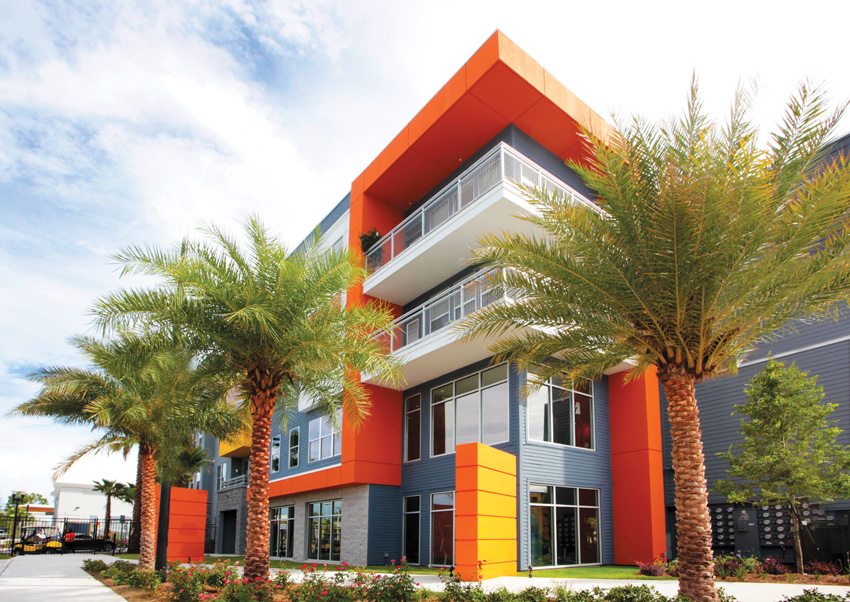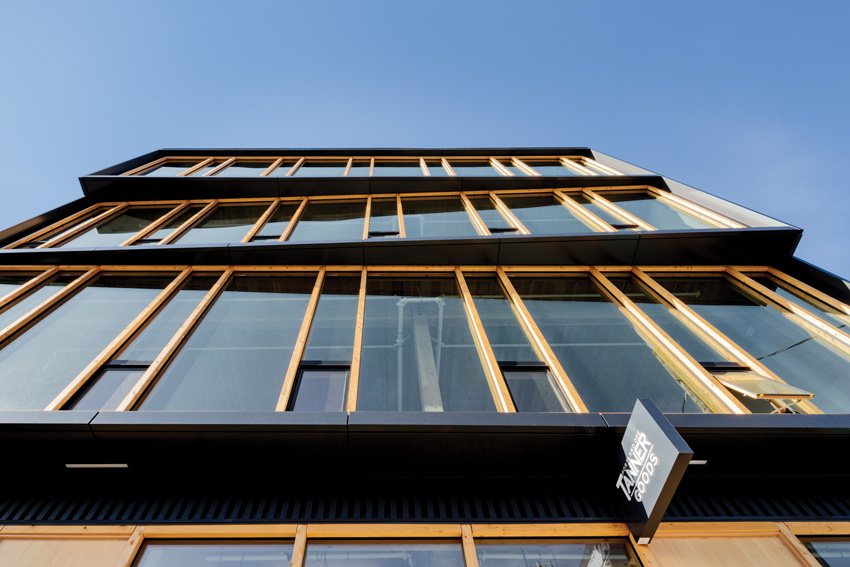Wood and Evolving Codes: The 2018 IBC and Emerging Wood Technologies
Green Building Codes, Standards, and Rating Systems
In addition to requirements designed to ensure safety and structural performance, a growing number of codes, standards, and rating systems seek to minimize a building’s negative impacts—and even promote positive contributions—to the environment.
The most recent example is the International Green Construction Code (IgCC), most recently updated in November 2018. Adopted by 14 states and the District of Columbia,19 it is the latest phase in an evolution that’s included two American National Standards (covering residential and nonresidential construction), the California Green Building Standards Code (CALGreen), and ASHRAE 189.1, a code intended for commercial green building published by the American Society of Heating, Refrigerating, and Air-Conditioning Engineers (ASHRAE) in cooperation with the Illuminating Engineering Society of North America (IES) and U.S. Green Building Council (USGBC).20 The 2018 IgCC, was revised to align with LEED requirements in an effort to promote adoption.
The IgCC covers subject areas typically found in any green building effort, including site, materials, energy, water, and indoor environment. The IgCC is primarily a voluntary code that jurisdictions have adopted to provide guidance regarding public or publicly funded buildings. It includes “mandatory” provisions within all subject areas as well as recommended provisions and electives. It is potentially applicable to almost every commercial building project, including additions and repairs. In terms of material use, the IgCC’s key mandatory requirement is that at least 55 percent of materials (based on mass, volume or cost) be used, recycled, bio-based, and/or indigenous in any combination. Wood can play a key role in helping a project meet this requirement.
The 55 percent rule need not be met when a whole building life-cycle assessment (LCA) is performed. LCA is a scientific approach to evaluation that considers the impact of materials over their entire life cycles, from extraction or harvest through manufacturing, transportation, installation, use, maintenance, and disposal or recycling. When integrated into green building codes, standards, and rating systems, LCA encourages design professionals to compare different building designs based on their true environmental impacts and to make informed choices about the materials they use. It replaces the prescriptive approach to material selection that’s been common until now, which assumes that certain prescribed practices—such specifying products with recycled content—are better for the environment regardless of the product’s manufacturing process or disposal. Comparative studies show that building with wood results in lower negative environmental impacts than steel or concrete in terms of embodied energy, air, and water pollution and greenhouse gas emissions.20, 21
For example, an LCA analysis compares two big-box retail buildings in the United Sates: a reference building constructed with concrete and steel, and a comparison building constructed with wood. Not only did the wood building cost 22 percent less to build, but its environmental footprint also was significantly lower. The study focused on the six LCA indicators required for the LEED v4 whole-building LCA credit: global warming potential, ozone depletion potential, acidification potential, eutrophication potential, smog potential, and nonrenewable energy use. In all areas except ozone depletion potential, the wood building outperformed the reference building. The wood building also required 14 percent less mass of materials than the conventional building.22
In the United States, LCA is included in the Green Globes rating system and the American National Standard based on Green Globes, ANSI/GBI 01-2010: Green Building Assessment Protocol for Commercial Buildings, as well as the ICC 700 National Green Building Standard. It is part of both CALGreen and ASHRAE 189.1, and optional LCA credits related to LCA were recently added to LEED v4. Although LCA isn’t mandatory in the IgCC, the elimination of the “55 percent requirement” is a powerful incentive for its use.
Conclusion
The number and diversity of wood buildings that demonstrate the possibilities of structural wood has proliferated in recent years, revealing the “wood revolution” as more than a passing trend. The latest building codes recognize wood’s safety and structural performance capabilities and recognize the newer systems such as CLT. As these systems are demonstrated in ever taller buildings and innovative applications, building designers will no doubt feel compelled to embrace the possibilities of structural wood and enjoy the co-benefits, including sustainability, durability, strength, and resilience.Andrew A. Hunt is vice president of Confluence Communications and has been a writer and consultant in the green building and building science industry for over a decade. He has authored more than 100 continuing education and technical publications as part of a nationwide practice. www.confluencecommunications.com
End Notes
1Showalter, John. “Building Codes.” Construction Today. 20 October 2015. Web. 7 June 2018.
2“2021 IBC, 2018 Group A, Tall Mass Timber Proposals Review Guide. American Wood Council. Web. 7 June 2018.
32018 International Building Code. International Code Council. August 2017. Web. 7 June 2018.
4Post, Nadine. “Fire Tests Inspire More Robust Timber Product Standard.” Engineering News Record. 7 March 2018. Web. 7 June 2018.
5“Earthquake-Resistant Design Concepts.” FEMA P-749. Federal Emergency Management Agency. December 2010. Web. 7 June 2018.
6Graf, William. “The ShakeOut Scenario: Woodframe Buildings.” United States Geological Survey and California Geological Survey. May 2008. Web. 7 June 2018.
7“Seismic Safety Inventory of California Public Schools.” California Department of General Services. November 2002. Web. June 2018.
8Christovasilis, I.P. et al. “Seismic Testing of a Full-Scale Wood Structure on Two Shake Tables.” The 14th World Conference on Earthquake Engineering. October 2008. Web. 7 June 2018.
9El Kouarti, Joyce. “Build Better, Stronger, Faster with CLT.” U.S Department of Agriculture. 4 April 2017. Web. 7 June 2018.
10“Earthquake Shake Tests at UC San Diego Toward 20-story Earthquake-safe Buildings Made from Wood.” UC San Diego News Center. 13 July 2017. Web. 7 June 2018.
11Gopu, Vajaya. “Performance of Light-frame Structures Subject to Extreme Wind Loads.” The Eighth Asia-Pacific Conference on Wind Engineering. December 2013. Web. 7 June 2018.
12“Summary Report on Building Performance, 2004 Hurricane Season.” FEMA 490. Federal Emergency Management Association. March 2005. Web. 7 June 2018.
13Thorburn, Steve. “Acoustical Considerations for Mixed-Use Wood-Frame Buildings.” WoodWorks Wood Products Council. June 2014. Web. 7 June 2018.
14“Wood Buildings Aim High: Benefits and Engineering Challenges of Podium Design.” WoodWorks Wood Products Council. 2011. Web. 7 June 2018.
15Podesto, Lisa. “Maximizing Value with Mid-Rise Construction.” WoodWorks Wood Products Council. 2015. Web. 7 June 2018.
16“Wood as a Restorative Material in Healthcare Environments.” FPInnovations. February. 2015. Web. 7 June 2018.
17“www.awc.org/news/2018/12/19/awc-tall-mass-timber-code-changes-get-final-approval, www.woodworks.org/wp-content/uploads/wood_solution_paper-TALL-WOOD.pdf, awc.org/tallmasstimber
18International Code Council Code Adoption Map. International Code Council. Web. 7 June 2018.
19More information on the International Green Construction Code is available from Dovetail Partners at www.dovetailinc.org.
20Piccardo, Chiara and Magliocco, Adriano. “The Environmental Profile of Wood in the Building Industry Today: Comments on the Results of Some LCA Studies.” American Journal of Civil Engineering and Architecture. 2013. Web. 7 June 2018.
21Bribián, Ignacio Zabalza et al. “Life-cycle assessment of building materials: Comparative analysis of energy and environmental impacts and evaluation of the eco-efficiency improvement potential.” Building and Environment. 2011. Web. 7 June 2018.
22“Big Box Retail: Wood Saves nearly $1 Million.” WoodWorks Wood Products Council. 2015. Web. 7 June 2018.
 |
Advances in wood construction reimagine the future of the built environment, combining strength with sustainability. Think Wood provides commercial, multifamily and single-family home design and build resources to architects, developers, and contractors. Explore www.thinkwood.com for continuing education, research, design tools, and innovative project profiles. |











